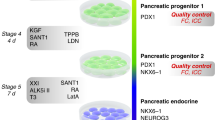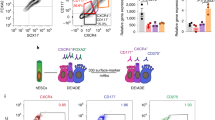Abstract
Here, we describe a basic protocol for the in vitro differentiation of mouse embryonic stem (ES) cells into insulin-producing cells. The three-step protocol comprises (i) the formation of embryoid bodies, (ii) the spontaneous differentiation of embryoid bodies into progenitor cells of ecto-, meso- and endodermal lineages, and (iii) the induction of differentiation of early progenitors into the pancreatic lineage. Differentiated cells can be obtained within approximately 33 d. Differentiation induction by growth and extracellular-matrix factors, including laminin, nicotinamide and insulin, leads to the formation of ES-derived progeny that resembles cells committed to the pancreatic lineage. During differentiation, transcript levels of genes expressed in early pancreatic cells are upregulated. Continued differentiation results in the development of C-peptide/insulin-positive islet-like clusters that release insulin upon glucose stimulation. Differentiated ES cells that overexpress the pancreatic developmental control gene Pax4 develop insulin-secretory granules and reveal functional properties with respect to the pancreas-specific ATP-modulated K+ channel and the normalization of glycemia of streptozotocin-treated diabetic mice.
*Note: In the version of this article originally published online, several citations of refs. 37 and 38 should have referred to ref. 35; "CRG8" should have read "CGR8" in the Materials section; some information was omitted from the Reagent Setup listings for ES-cell culture medium and Solution A for ELISA; the heading for Step 16B should have read "(B) 10 μg cm–2 collagin I–coated dishes" (not 10 μg cm–2); Step 46 should have referred to a total volume of 588.75 μl for the PCR master mix (not 587.5 μl); a query to the author at the end of the first subsection of Anticipated Results should have been removed; and the labels in Figure 3 should have been aligned more precisely with respect to the panels. These errors have been corrected in all versions of the article.
*Note: In the version of this article originally published online, the Reagent Setup listings for ES-cell culture medium should have included the following additional ingredients: “100 μM β-mercaptoethanol, 0.05 mg ml-1 streptomycin, 0.03 mg ml-1 penicillin, 15 % FCS, and 1000 units ml-1 LIF.” In the HTML version, the ingredients were erroneously inserted in the wrong location. These errors have been corrected in the HTML and PDF versions of the article.
This is a preview of subscription content, access via your institution
Access options
Subscribe to this journal
Receive 12 print issues and online access
$259.00 per year
only $21.58 per issue
Buy this article
- Purchase on Springer Link
- Instant access to full article PDF
Prices may be subject to local taxes which are calculated during checkout



Similar content being viewed by others
Change history
05 October 2006
In the version of this article originally published online, the Reagent Setup listings for ES-cell culture medium should have included the following additional ingredients: “100 µM β-mercaptoethanol, 0.05 mg ml-1 streptomycin, 0.03 mg ml-1 penicillin, 15 % FCS, and 1000 units ml-1 LIF.” In the HTML version, the ingredients were erroneously inserted in the wrong location. These errors have been corrected in the HTML and PDF versions of the article.
References
Wobus, A.M. & Boheler, K.R. Embryonic stem cells: prospects for developmental biology and cell therapy. Physiol. Rev. 85, 635–678 (2005).
Ying, Q.L., Stavridis, M., Griffiths, D., Li, M. & Smith, A. Conversion of embryonic stem cells into neuroectodermal precursors in adherent monoculture. Nat. Biotechnol. 21, 183–186 (2003).
Kahan, B.W. et al. Pancreatic precursors and differentiated islet cell types from murine embryonic stem cells: an in vitro model to study islet differentiation. Diabetes 52, 2016–2024 (2003).
Soria, B. et al. Insulin-secreting cells derived from embryonic stem cells normalize glycemia in streptozotocin-induced diabetic mice. Diabetes 49, 157–162 (2000).
Leon-Quinto, T., Jones, J., Skoudy, A., Burcin, M. & Soria, B. In vitro directed differentiation of mouse embryonic stem cells into insulin-producing cells. Diabetologia 47, 1442–1451 (2004).
Lumelsky, N. et al. Differentiation of embryonic stem cells to insulin-secreting structures similar to pancreatic islets. Science 292, 1389–1394 (2001).
Hori, Y. et al. Growth inhibitors promote differentiation of insulin-producing tissue from embryonic stem cells. Proc. Natl Acad. Sci. USA 99, 16105–16110 (2002).
Sipione, S., Eshpeter, A., Lyon, J.G., Korbutt, G.S. & Bleackley, R.C. Insulin expressing cells from differentiated embryonic stem cells are not β cells. Diabetologia 47, 499–508 (2004).
Blyszczuk, P. et al. Expression of Pax4 in embryonic stem cells promotes differentiation of nestin-positive progenitor and insulin-producing cells. Proc. Natl. Acad. Sci. USA 100, 998–1003 (2003).
Miyazaki, S., Yamato, E. & Miyazaki, J. Regulated expression of pdx-1 promotes in vitro differentiation of insulin-producing cells from embryonic stem cells. Diabetes 53, 1030–1037 (2004).
Shiroi, A. et al. Differentiation of embryonic stem cells into insulin-producing cells promoted by Nkx2.2 gene transfer. World J. Gastroenterol. 11, 4161–4166 (2005).
Rajagopal, J., Anderson, W.J., Kume, S., Martinez, O.I. & Melton, D.A. Insulin staining of ES cell progeny from insulin uptake. Science 299, 363 (2003).
Gradwohl, G., Dierich, A., LeMeur, M. & Guillemot, F. neurogenin3 is required for the development of the four endocrine cell lineages of the pancreas. Proc. Natl Acad. Sci. USA 97, 1607–1611 (2000).
Schwitzgebel, V.M. et al. Expression of neurogenin3 reveals an islet cell precursor population in the pancreas. Development 127, 3533–3542 (2000).
Nakagawa, Y. & O'Leary, D.D. Combinatorial expression patterns of LIM-homeodomain and other regulatory genes parcellate developing thalamus. J. Neurosci. 21, 2711–2725 (2001).
Lee, J. et al. Neurogenin3 participates in gliogenesis in the developing vertebrate spinal cord. Dev. Biol. 253, 84–98 (2003).
Habener, J.F., Kemp, D.M. & Thomas, M.K. Minireview: transcriptional regulation in pancreatic development. Endocrinology 146, 1025–1034 (2005).
Okabe, S., Forsberg-Nilsson, K., Spiro, A.C., Segal, M. & McKay, R.D. Development of neuronal precursor cells and functional postmitotic neurons from embryonic stem cells in vitro. Mech. Dev. 59, 89–102 (1996).
Blyszczuk, P. et al. Embryonic stem cells differentiate into insulin-producing cells without selection of nestin-expressing cells. Int. J. Dev. Biol. 48, 1095–1104 (2004).
Kania, G., Blyszczuk, P. & Wobus, A.M. The generation of insulin-producing cells from embryonic stem cells — a discussion of controversial findings. Int. J. Dev. Biol. 48, 1061–1064 (2004).
Kania, G., Blyszczuk, P., Czyz, J., Navarrete-Santos, A. & Wobus, A.M. Differentiation of mouse embryonic stem cells into pancreatic and hepatic cells. Methods Enzymol. 365, 287–303 (2003).
Hansson, M. et al. Artifactual insulin release from differentiated embryonic stem cells. Diabetes 53, 2603–2609 (2004).
Paek, H.J., Morgan, J.R. & Lysaght, M.J. Sequestration and synthesis: the source of insulin in cell clusters differentiated from murine embryonic stem cells. Stem Cells 23, 862–867 (2005).
Shi, Y. et al. Inducing embryonic stem cells to differentiate into pancreatic beta cells by a novel three-step approach with activin A and all-trans retinoic acid. Stem Cells 23, 656–662 (2005).
Kubo, A. et al. Development of definitive endoderm from embryonic stem cells in culture. Development 131, 1651–1662 (2004).
Vaca, P. et al. Induction of differentiation of embryonic stem cells into insulin-secreting cells by fetal soluble factors. Stem Cells 24, 258–265 (2006).
Strubing, C. et al. Differentiation of pluripotent embryonic stem cells into the neuronal lineage in vitro gives rise to mature inhibitory and excitatory neurons. Mech. Dev. 53, 275–287 (1995).
Wobus, A.M. et al. Retinoic acid accelerates embryonic stem cell-derived cardiac differentiation and enhances development of ventricular cardiomyocytes. J. Mol. Cell Cardiol. 29, 1525–1539 (1997).
Drab, M. et al. From totipotent embryonic stem cells to spontaneously contracting smooth muscle cells: a retinoic acid and db-cAMP in vitro differentiation model. FASEB J. 11, 905–915 (1997).
Micallef, S.J. et al. Retinoic acid induces Pdx1-positive endoderm in differentiating mouse embryonic stem cells. Diabetes 54, 301–305 (2005).
D'Amour, K.A. et al. Efficient differentiation of human embryonic stem cells to definitive endoderm. Nat. Biotechnol. 23, 1534–1541 (2005).
Yasunaga, M. et al. Induction and monitoring of definitive and visceral endoderm differentiation of mouse ES cells. Nat. Biotechnol. 23, 1542–1550 (2005).
Tada, S. et al. Characterization of mesendoderm: a diverging point of the definitive endoderm and mesoderm in embryonic stem cell differentiation culture. Development 132, 4363–4374 (2005).
Nagy, A., Rossant, J., Nagy, R., Abramow-Newerley, W. & Roder, J. C. Derivation of compleley cell culture-derived mice from early-passage embryonic stem cells. Proc. Natl. Acad. Sci. USA 90, 8424–8428 (1993).
Smith, A.G. Culture and differentiation of embryonic stem cells. J. Tiss. Cult. Meth. 13, 89–94 (1991).
Smith, D.B. & Johnson, K.S. Single-step purification of polypeptides expressed in Escherichia coli as fusions with glutathione S-transferase. Gene 67, 31–40 (1988).
Melloul, D., Marshak, S. & Cerasi, E. Regulation of pdx-1 gene expression. Diabetes 51 (Suppl. 3), S320–S325 (2002).
Wobus, A.M., Guan, K., Yang, H.T. & Boheler, K.R. Embryonic stem cells as a model to study cardiac, skeletal muscle, and vascular smooth muscle cell differentiation. Methods Mol. Biol. 185, 127–156 (2002).
Acknowledgements
We acknowledge the excellent assistance of O. Weiss, S. Sommerfeld, K. Meier and K. Deist. We thank Dr G. Wanner, Ludwig Maximilian University, Munich, Germany, for scanning electron microscopy of EBs. This work has been financially supported by the German Research Foundation (DFG, WO 503/3), the Ministry of Education, Science and Technology (BMBF; 01GN0106) and the EU Program 'FunGenES'.
Author information
Authors and Affiliations
Corresponding author
Ethics declarations
Competing interests
The authors declare no competing financial interests.
Rights and permissions
About this article
Cite this article
Schroeder, I., Rolletschek, A., Blyszczuk, P. et al. Differentiation of mouse embryonic stem cells to insulin-producing cells. Nat Protoc 1, 495–507 (2006). https://doi.org/10.1038/nprot.2006.71
Published:
Issue Date:
DOI: https://doi.org/10.1038/nprot.2006.71
This article is cited by
-
Stem cells differentiation into insulin-producing cells (IPCs): recent advances and current challenges
Stem Cell Research & Therapy (2022)
-
Stem cells as a potential therapy for diabetes mellitus: a call-to-action in Latin America
Diabetology & Metabolic Syndrome (2019)
-
Direct reprogramming of fibroblasts into neural stem cells by single non-neural progenitor transcription factor Ptf1a
Nature Communications (2018)
-
Can We Re-Engineer the Endocrine Pancreas?
Current Diabetes Reports (2018)
-
The combined effect of PDX1, epidermal growth factor and poly-L-ornithine on human amnion epithelial cells’ differentiation
BMC Developmental Biology (2016)
Comments
By submitting a comment you agree to abide by our Terms and Community Guidelines. If you find something abusive or that does not comply with our terms or guidelines please flag it as inappropriate.



